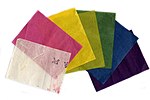Mino washi (美濃和紙, Mino paper) is a type of Japanese paper created in Gifu Prefecture, Japan. Washi is made from the paper mulberry which is a plant that...
4 KB (488 words) - 23:37, 12 February 2024
Karakami (京からかみ) Maniaigami Marumorigami Mashi Mimitsugami Mino Bijutsu Kogeishi (美濃美術工芸紙) Mino washi (美濃和紙) or Minogami (美濃紙) Misugami Miyachigami Miyamagami...
2 KB (275 words) - 13:56, 18 July 2024
kilometres (45.18 sq mi). The city is renowned for traditional Japanese Mino washi paper and its streets, which are in the style of the early Edo period...
12 KB (599 words) - 22:47, 2 August 2024
elegant and refined world of washi". Toki. 30 August 2015. Archived from the original on 6 April 2017. "Washi paper in Mino". ANA. Archived from the original...
11 KB (1,156 words) - 11:04, 16 August 2024
surrounding natural resources to create both traditional industries (including Mino washi and agriculture) and tourism opportunities such as cormorant fishing....
65 KB (6,616 words) - 23:34, 6 June 2024
to just tens of thousands of umbrellas. Gifu Umbrellas are made using Mino washi, a strong local paper. A number of natural materials are used in the production...
2 KB (283 words) - 15:59, 11 December 2022
boats used in cormorant fishing. The Mino region has long been known for its high-quality paper called Mino washi, which is stronger and thinner than most...
36 KB (2,690 words) - 06:08, 11 July 2024
chōchin-obake. Gifu is known for its Gifu lanterns, a kind of chōchin made from mino washi. Chōchin at Minatogawa Shrine in Kōbe White chōchin decorated with tomoe...
10 KB (907 words) - 16:41, 13 August 2024
strong fans entirely handmade from washi (Japanese paper) and bamboo. The covers for the fans are made using Mino washi, while the base structure is made...
2 KB (191 words) - 06:25, 21 September 2023
Gifu Lanterns are built around a thin frame and layered with pieces of Mino washi. The paper can either be plain, showing off the flickers of light, or...
3 KB (416 words) - 12:12, 29 October 2022
bamboo (33), metalwork (16), Butsudan and Buddhist ritual implements (17), washi (9), writing tools (10), stonework (4), precious stonework (2), dolls and...
49 KB (1,032 words) - 19:30, 2 September 2024
sweet potato), and miso pan Yakunara Mug Cup Mo, a manga and anime promoting Mino ware and other meibutsu of Tajimi, Gifu Prefecture Yatogame-chan Kansatsu...
47 KB (1,082 words) - 10:02, 16 January 2024
been the center of swordmaking in Japan for many centuries. Mino is the home of Mino washi, a type of paper known for its strength. Gujō is known for its...
3 KB (296 words) - 20:56, 3 February 2022
domestically and internationally exhibited in museums such as the Mino Washi Museum in Mino, Japan, the Pennsylvania Academy of Art Museum in Philadelphia...
11 KB (929 words) - 04:08, 27 September 2023
Mongolia 1953 Japan Eagle of the Pacific (Operation Kamikaze) Taiheiyo no washi (太平洋の鷲) Ishirō Honda Admiral Isoroku Yamamoto 1953 United States El Alaméin...
166 KB (654 words) - 03:52, 27 July 2024
(820 ft) and, at this scale, are sometimes described as "murals" (壁画). Tosa washi was selected as the official support for the paintings, although not all...
75 KB (2,330 words) - 02:14, 19 April 2024
Mino Province Gifu Prefecture 1969 Washi Hosokawa-shi (細川紙) 1978 Washi Najio-ganpishi (名塩雁皮紙) Made from the ganpi plant Hyōgo Prefecture 2002 Washi Sekishū-banshi...
52 KB (2,456 words) - 02:08, 11 January 2024
regardless of construction. Japanese books were traditionally made of washi, or Japanese paper. This durable, fibrous paper does not easily yellow or...
21 KB (2,976 words) - 23:12, 22 August 2024
engineer and lecturer in descriptive geometry. JPL · 9062 9063 Washi 1992 YS Shinsho Washi (born 1951), the director of the Sakai City Planetarium. JPL ·...
163 KB (735 words) - 08:45, 25 July 2024
fishing, the production of Traditional Chinese medicines, production of washi paper, and sericulture, which raised its actual kokudaka to over 200,000...
23 KB (2,664 words) - 10:56, 21 July 2022
(博多人形). The Japanese art of making paper from the mulberry plant called washi (和紙) is thought to have begun in the 6th century. Dyeing paper with a wide...
32 KB (3,653 words) - 10:41, 9 May 2024
Properties] (in Japanese). Gifu Prefecture. 2 March 2015. Retrieved 3 July 2015. "Washi, craftsmanship of traditional Japanese hand-made paper". UNESCO. Retrieved...
7 KB (239 words) - 13:39, 22 March 2022
Kansai speakers especially wate and wai. Elderly Kansai men frequently use washi as well as other western Japan. Uchi is famous for the typical feminine...
81 KB (8,767 words) - 11:26, 4 May 2024
the middle of the Edo period, the clan's finances were prosperous, with washi paper being monopolized and new rice fields developed. However, in the late...
11 KB (783 words) - 00:24, 15 August 2023
neighborhood of the city of Ayabe, Kyoto. The Tani clan was originally from Mino Province and were early retainers of Oda Nobunaga. Tani Moritomo participated...
10 KB (516 words) - 13:02, 14 February 2024
flood control projects and opened up new rice lands. He also developed washi paper as a revenue source for the domain. His wife was the daughter of Uesugi...
19 KB (2,264 words) - 19:35, 7 April 2023
Kanō-juku (category Mino Province)
highway, making it the largest post town in Mino Province. The town was noted for its production of washi (Japanese paper). It is located 412.8 kilometers...
6 KB (629 words) - 09:52, 10 May 2024
major source of antimony in the Edo period, and the domain also developed washi paper as a domain monopoly and a major source of revenue. Nevertheless,...
10 KB (750 words) - 02:48, 3 May 2024


















